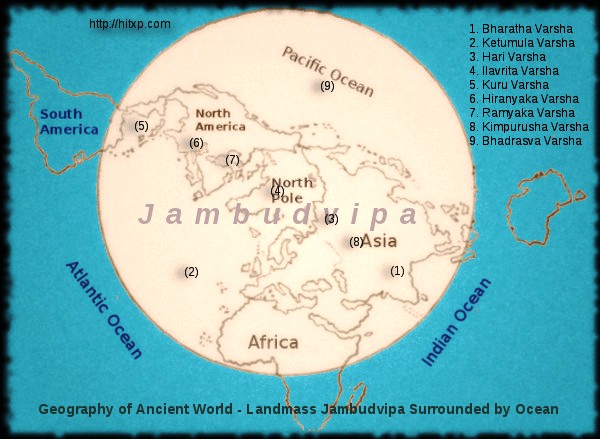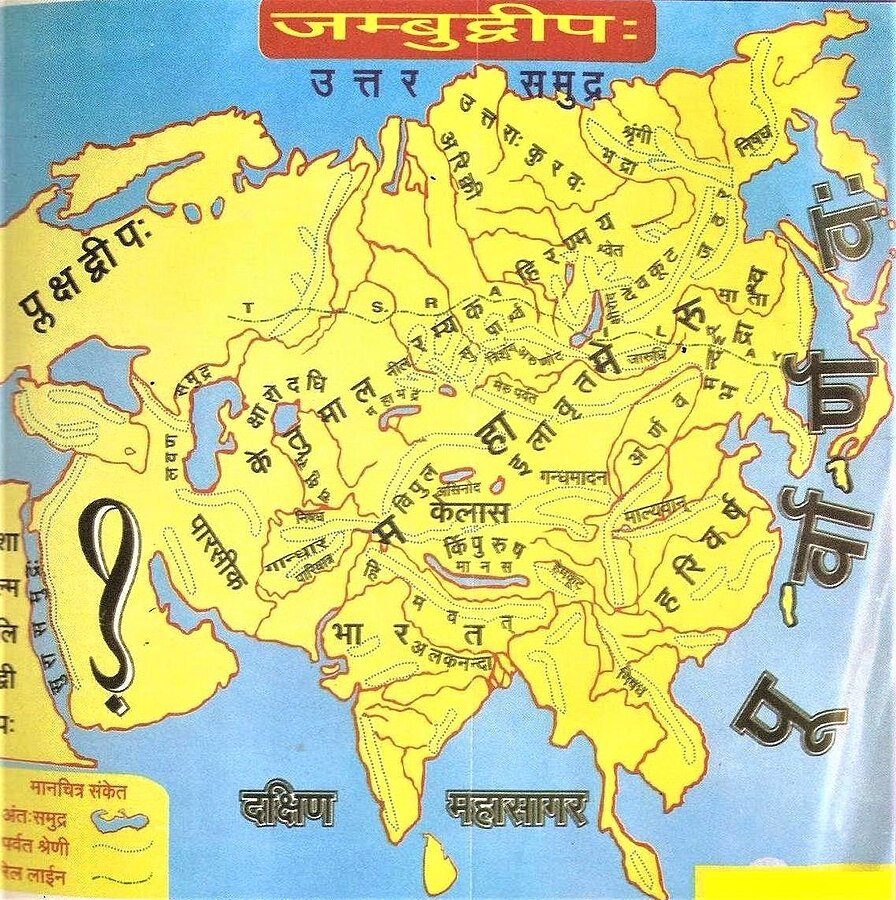Jambu Dweep, as described in ancient Hindu scriptures, is a mystical and significant landmass in the Vedic cosmology. It holds a central place in the sacred texts, particularly in the Puranas, Ramayana, and Mahabharata, where it is said to be the abode of various civilizations, deities, and mythological events. According to these ancient scriptures, Jambu Dweep is divided into nine regions, each with its distinct characteristics, geography, and importance. These divisions, often referred to as dweepas, provide not only insights into ancient geography but also into the cultural, spiritual, and historical landscape of ancient India and beyond.
In this article, we will explore the nine divisions of Jambu Dweep, focusing on their names and significance, uncover how these geographical descriptions tie into the broader narrative of ancient Indian history and culture, and identify the modern countries that correspond to these ancient regions.
What is Jambu Dweep?
Jambu Dweep is part of the larger cosmic map of the universe as detailed in Hindu cosmology. The term Jambu refers to a mythical tree or island, while Dweep means “island” or “region.” According to these texts, Jambu Dweep is located at the center of the world, surrounded by oceans and other lands. It is considered the most sacred part of the Earth, and within this sacred land, there are nine subdivisions, each known as a dweep. These divisions are often described in great detail, providing information about the geographical and cultural diversity of the ancient world as it was perceived by early civilizations.
The Nine Divisions of Jambu Dweep
The nine divisions of Jambu Dweep are mentioned in several ancient texts, including the Srimad Bhagavatam and the Vishnu Purana. Each of these divisions is believed to have its own unique characteristics, ranging from geographical features to cultural significance. Let’s delve into each of these divisions and see how they correlate to present-day countries.
Bharatvarsha (Bharata)
Bharatvarsha, the most significant and well-known of the divisions, corresponds to the modern-day Indian subcontinent. This region is considered the home of the great epics, the Ramayana and the Mahabharata, and has always been associated with profound spiritual practices, rich cultural heritage, and a deep philosophical tradition. Bharatvarsha is said to be the birthplace of numerous ancient civilizations and is regarded as the land where the battle between good and evil unfolds, particularly through the stories of Lord Rama and Lord Krishna. Modern Countries: India, Pakistan, Nepal, Bangladesh, Sri Lanka, Bhutan, and Myanmar.Harivarsha
Harivarsha is another important division, which is said to be located in the north-eastern direction of Jambu Dweep. It is described as a land of immense prosperity, where the inhabitants are dedicated to Lord Vishnu. The land of Harivarsha is thought to be blessed with peace and spiritual purity, where people live in harmony with nature and the divine. Modern Countries: This region could correspond to parts of East Asia, including China, Mongolia, and Korea, as it lies in the northeastern direction.Kimpurusha
Kimpurusha, located to the north of Bharatvarsha, is described as a region populated by mythological beings known as Kimpurushas. These beings are often depicted as human-like creatures with the heads of animals or divine qualities. This division represents the fusion of human and divine characteristics, symbolizing the interconnection between the mortal and the immortal realms. Modern Countries: The region could correspond to Central Asia, including parts of Kazakhstan, Russia, and Turkmenistan.Ketuvarsha
Ketuvarsha, located to the south of Bharatvarsha, is known for its exotic nature and wealth. This region is mentioned as a place of great spiritual significance, where people follow strict ascetic practices and seek enlightenment through self-discipline and spiritual endeavors. Modern Countries: Ketuvarsha could correspond to regions in South East Asia, such as Indonesia, Malaysia, and parts of Thailand and Cambodia, which were historically centers for spiritual practices.Ramya
Ramya is another region located to the east of Bharatvarsha. It is depicted as a land of beauty and prosperity, where the people live in perfect harmony with nature. The division is associated with the worship of the goddess Lakshmi and is considered a place where material and spiritual wealth coexist. Modern Countries: Ramya is likely to correspond to Southeast Asia, including Vietnam, Laos, Cambodia, and Thailand.Suvarchala
Suvarchala, located to the west of Bharatvarsha, is known as a land of brilliance and light. The inhabitants of Suvarchala are described as possessing exceptional intellect and wisdom. This region is often associated with the worship of the sun god, Surya, and is believed to be a place where enlightenment and knowledge flourish. Modern Countries: Suvarchala could be associated with Middle Eastern regions such as Iran, Iraq, and parts of Turkey and Syria, known historically for their intellectual contributions and worship of solar deities.Varuna
Varuna, as the name suggests, is a land governed by the cosmic god of water, Varuna. This division is believed to be rich in rivers, lakes, and seas, and it is associated with prosperity derived from the natural abundance of water resources. Modern Countries: Varuna could correspond to Eastern Mediterranean countries such as Egypt, Israel, Lebanon, Jordan, and parts of Saudi Arabia, known for their water resources and trade routes.Brahmapura
Brahmapura, located to the south-west, is a region of divine enlightenment and spiritual development. It is often associated with the worship of Lord Brahma, the creator of the universe. This division is believed to be the place where the highest knowledge and wisdom are pursued. Modern Countries: Brahmapura could align with parts of India, particularly Uttarakhand (home to Badrinath) and Himachal Pradesh, known for their spiritual significance and temples dedicated to Brahma and other deities.Bhuvarsha
Bhuvarsha is another significant division that lies in the southern part of Jambu Dweep. This land is known for its strong connection to the Earth and the natural world. The inhabitants of Bhuvarsha are believed to be deeply in tune with nature, living in a way that is sustainable and spiritually connected to the land. Modern Countries: Bhuvarsha could represent parts of Southern India, Sri Lanka, Bangladesh, and Myanmar, where the worship of natural elements like the Earth, trees, rivers, and mountains is prominent.

The Importance of Jambu Dweep in Ancient Hindu Cosmology
The divisions of Jambu Dweep provide a fascinating glimpse into the worldview of ancient India. These regions were not just geographical markers but also symbolic of different aspects of life—spiritual, cultural, and natural. The nine dweepas reflect the complexity and diversity of the ancient world as understood through Hindu cosmology.
Jambu Dweep is often seen as a spiritual map, where each division represents a different path to spiritual growth and enlightenment. The people of these regions were not only aware of their immediate surroundings but also deeply connected to the divine forces that governed the universe. This interconnectedness between geography, spirituality, and culture is a hallmark of Hindu cosmology and reflects the holistic understanding of existence.
The nine divisions of Jambu Dweep, as described in Hindu scriptures, offer a profound understanding of ancient India’s geographical and spiritual landscape. These regions are more than just places; they symbolize various aspects of human life, culture, and spirituality. Whether it is Bharatvarsha, the land of righteousness and history, or Harivarsha, the region of devotion to Vishnu, each division has its own unique contribution to the spiritual and cultural heritage of the world.
As we explore these ancient divisions, it is essential to remember that they are not merely mythological constructs but reflections of a deep and sophisticated understanding of the cosmos. By critically analyzing and reflecting on these divisions, we can gain a better appreciation for the profound wisdom embedded in ancient Indian texts and traditions.
This exploration of Jambu Dweep invites us to rethink our understanding of history, geography, and spirituality and encourages us to dive deeper into the ancient wisdom that continues to shape our world today.



